179 Interesting Facts Will Blow Your Mind Part 1
 |
| Facts. Photo: ichemeblog.org |
1. Black apples exist
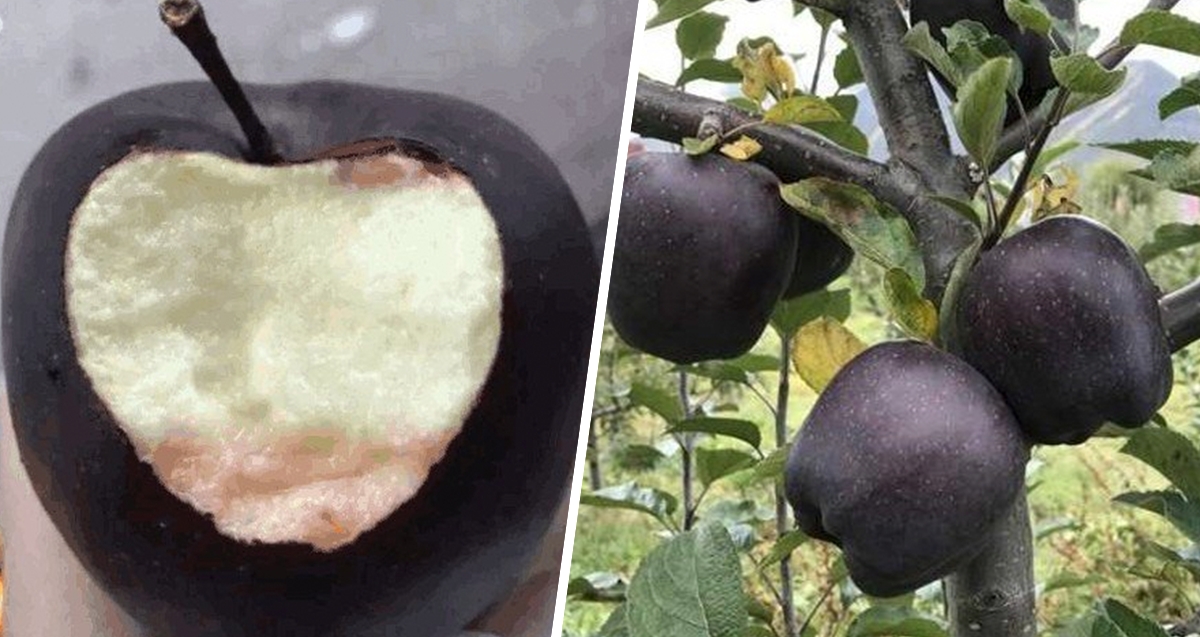 |
| Photo: twentytwowords.com |
We tend to think of apples as being red, though there are, of course, some popular green and yellow varieties. But did you know there are also black apples? Called Black Diamond apples, they're found in Tibet and are from the Hua Niu family of apples, also known as Chinese Red Delicious. Aside from the black outer color—actually an extremely dark shade of purple—these apples look just like other Red Delicious apples, down to the white flesh inside.
The main cause of why these fruits turn dark are the notable temperature differences between day and night, and the intense sunlight and ultraviolet light which causes their skin to go from the characteristic deep red to dark purple, according to Tribune.
Black Diamond apples are a bit of a mystery, even among experienced apple growers, as apart from the handful of sources listed in this article, there really isn’t much information about them online.
While fruit growers online claim that the pictures of the mysterious "Black Diamond apples" circulating online have been enhanced to make the fruits darker than they really are. But until someone gets their hands on these apples, there’s really no way to know who's right.
2. The heads on Easter Island have bodies
 |
| Photo: forbes.com |
To the surprise of many visitors to Easter Island, the famed statues have bodies! In the '10s Archaeologists have uncovered the bodies associated with the heads and found interesting discoveries that further our knowledge of the Easter Island civilization and how they created the monoliths, according to Forbes. While weathered and worn by centuries of exposure to the elements, many of them are still very beautiful.
3. Every 'c' in the Pacific Ocean is pronounced differently
The English language is quirky, and one of the best examples of that is in the way we pronounce the Pacific Ocean. Take your time to say it slowly, and you'll notice that each 'c' is said differently—the first with an 's' sound, the second as a hard 'ck' sound, and the third with a 'sh' sound.
4. Scotland has 421 words for “snow”
 |
According to theguardian, the claim that the Inuit have 50 words for snow has endured for decades, but it now looks as if the Scots have beaten that figure. Researchers on a new Scots thesaurus say they have found more than 400 Scots words for the white stuff. Some examples: sneesl (to start raining or snowing); feefle (to swirl); flinkdrinkin (light snow), “spitters” (small drops or flakes of wind-driven rain or snow), or “snaw-pouther” (fine driving snow).
Academics compiling the first Historical Thesaurus of Scots, which will include every word in the Scots language from earliest records until today, claim they have found 421 Scots words for snow. Other examples include “snaw” and “sneesl”, meaning to begin to rain or snow, and “skelf”, a large snowflake.
No matter the type of snow, there is a Scots word for it, according to the thesaurus, whether it is “feefle” (to swirl, as of snow round a corner), “flindrikin” (a slight snow shower), “spitters” (small drops or flakes of wind-driven rain or snow) or “snaw-pouther” (fine driving snow).
5. Johnny Appleseed’s fruits weren’t for eating
 |
Yes, there was a real John Chapman who planted thousands of apple trees on U.S. soil. But the apples on those trees were much more bitter than the ones you’d find in the supermarket today. “Johnny Appleseed” didn’t expect his fruits to be eaten whole, but rather made into hard apple cider, reported Reader's Digest.
6. The moon has moonquakes
 |
| Photo: scienceabc.com |
Just as the earth has earthquakes, the moon has—generating moonquakes, a new study based on Apollo mission data found. These moonquakes likely happen because the moon is quivering as it shrinks, researchers added. Less common and less intense than the shakes that happen here, moonquakes are believed by U.S. Geological Survey (USGS) scientists to occur due to tidal stresses connected to the distance between the Earth and the moon.
7. Kids Ask 300 Questions a Day
 |
| Questioning begins as early as 6am and doesn't stop until bedtime (Shutterstock/Elizaveta Galitckaia). |
Mums are bombarded with around 300 questions from their children on a daily basis, a new study has revealed, according to HinsduTimes.
And girls aged four are the most curious, asking an incredible 390 questions per day, the study by online retailer Littlewoods.com found
From breakfast at 7.19am to tea time at 7.59pm, the average British mum faces a testing 12.5 hour day of questioning - working out at one question every two minutes 36 seconds, the Telegraph reported.
Most questions are asked during meal times, young children rattling off 11, it revealed.
This is closely followed by a routine trip to the shops, prompting 10, and the reading of a bed-time story, which typically results in nine.
Interestingly, a huge 82 per cent of infants apparently go to their mum first rather than their dad if they have a query.
A quarter of children, 24 per cent, said they go to their mother first if they have a question because their dad will just say ask your mum.
8. The first oranges weren’t orange
Did you know that the first oranges were not actually orange? The original oranges from Southeast Asia were a tangerine-pomelo hybrid, and they were actually green. In fact, oranges in warmer regions like Vietnam and Thailand still stay green through maturity.
9. Bees Sometimes Sting Other Bees
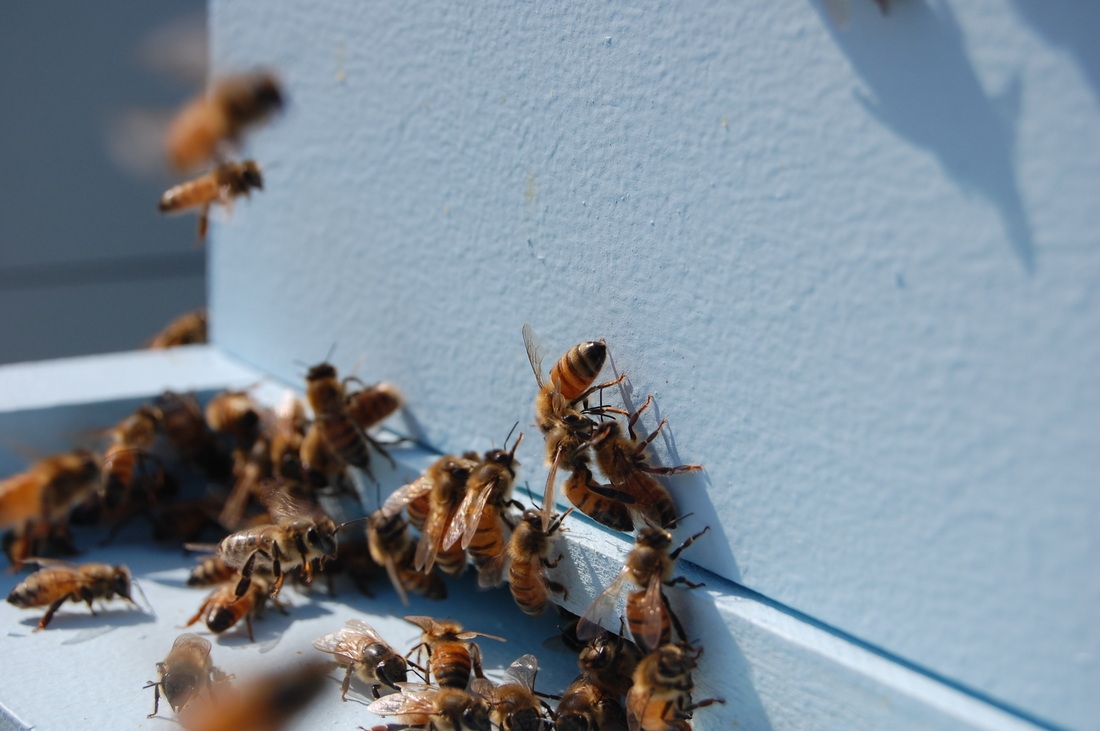 |
| Photo: awaggledance.weebly.com |
Bees are notorious for their stings, but humans aren’t the only ones who experience this pain in the neck (or the arm, or the leg…). In protecting their hives from outsiders, some “guard bees” will actually stay by the entrance and sniff the bees that come in. If there’s a rogue bee from another hive trying to steal some nectar, the guard bee will bite and even sting the intruder.
10. Goosebumps are meant to ward off predators
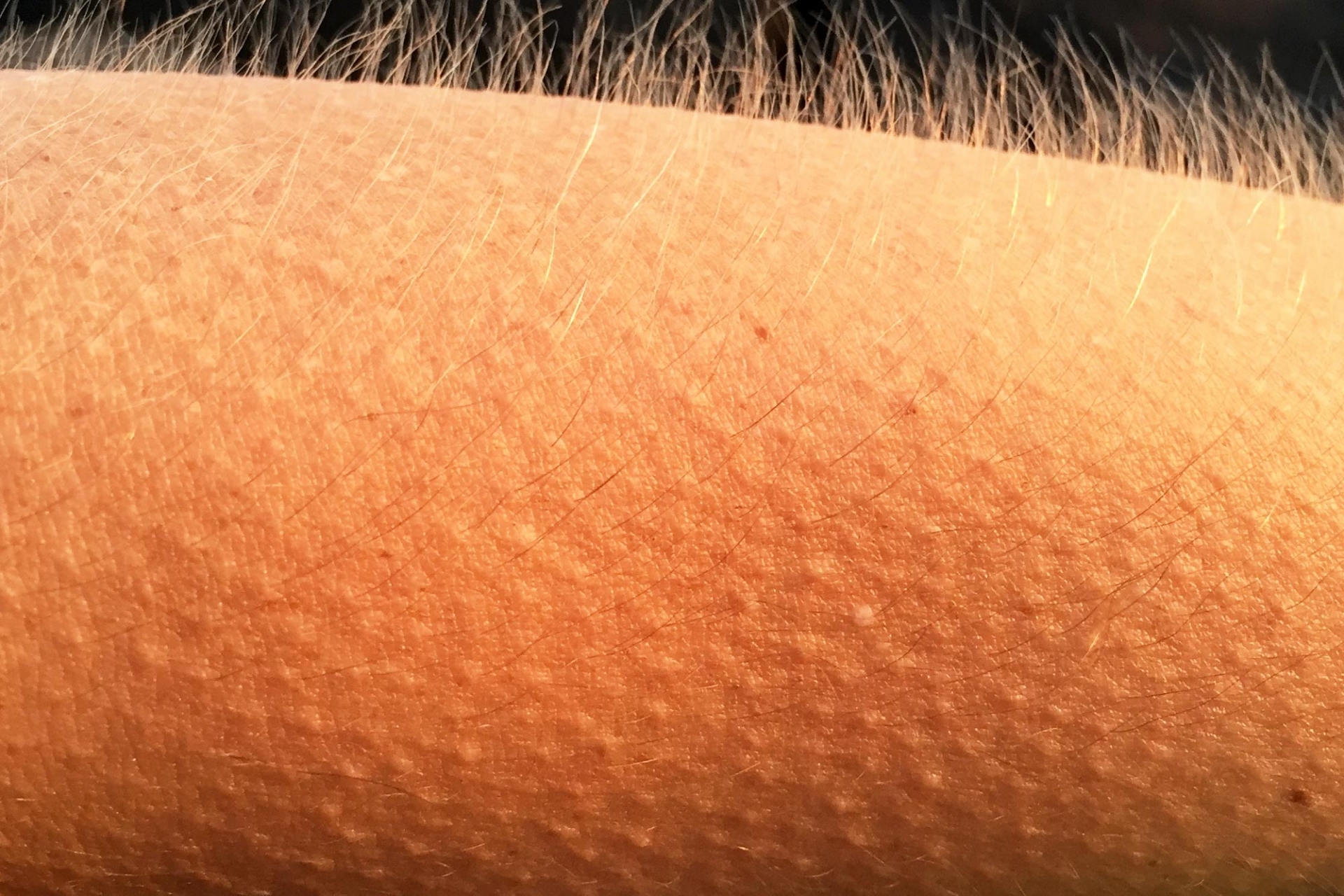 |
| Photo: scitechdaily.com |
Why do we get goosebumps? In this physiological reaction, small muscles attached to individual body hairs contract, which leads the hair to stand on end. We inherited this ability from our ancestors in part as a way for our (then) coat of body hair to capture air beneath it and in that way retain heat. But, as George A. Bubenik, a physiologist and professor of zoology at the University of Guelph in Ontario, Canada, explained to Scientific American, it also caused our ancestors to appear bigger than they were, helping to ward off predators when they were frightened or on the defense. With modern humans having less body hair, goosebumps no longer cause us to look that much more intimidating.
11. Butt-shaped robots are used to test phones
 |
| Photo: Techradar. |
If you've ever put your phone in the back pocket of your pants, you're probably aware that your backside poses a danger to it: People often forget their phone is there when they sit down, which can result in a crushed and broken device. That's why Samsung uses butt-shaped robots to test their products. According to Business Insider, the faux bums "'sit' on Samsung phones over and over again to test durability and bending."
12. The Total Weight of Ants Equals the Total Weight of People
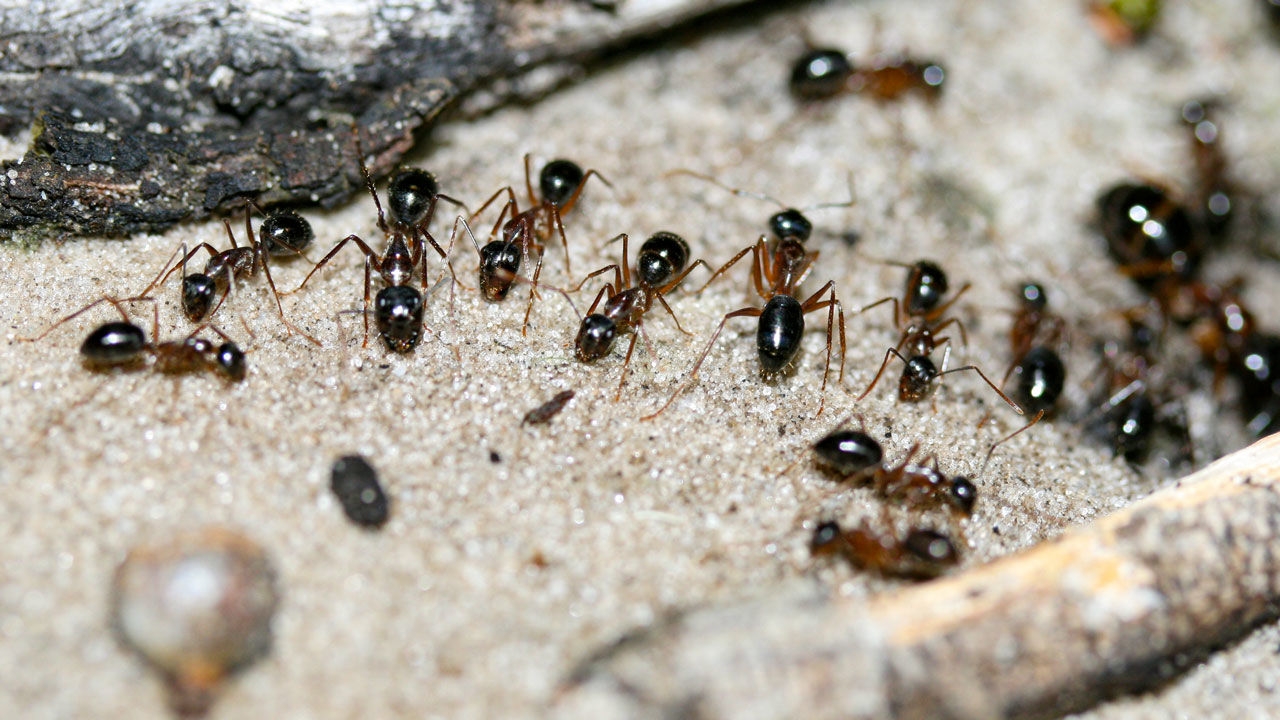 |
| Photo: sciencemag.org |
You’ve probably heard that the number of bugs on the planet exceeds the number of people many times over, but it can be hard to comprehend what that really looks like. Entomologists have estimated that there at least one million trillion insects and only 1 percent of that number is ants.
If you took all those ants (about ten thousand trillion) and put them on one side of a giant scale, you’d have to put all the humans on earth (7.4 billion) on the other side to balance it out. Yes, the total weight of all the ants on earth equals the weight of all the people, according to MSN.
13. Spending just a few months in Antarctica can shrink your brain
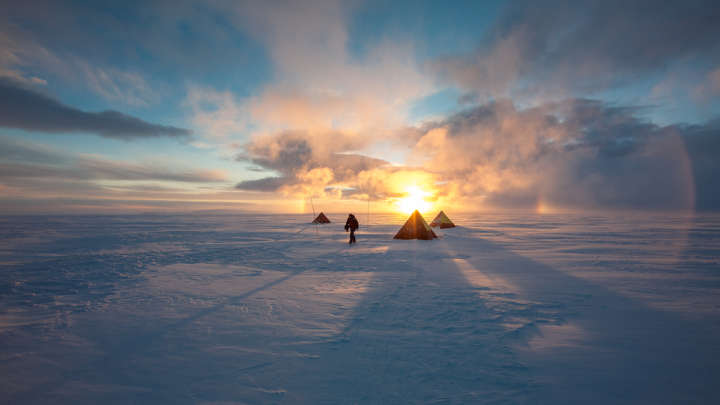 |
If you ever take a trip to Antarctica, be sure to do as much socializing as you possibly can, and come up with stimulating ways to keep yourself busy. Research published in the New England Journal of Medicine in Dec. 2019 explained that "brain imaging in eight polar expeditions before and after 14 months of isolation showed that the volume of the hippocampal dentate gyrus was lower than that in controls." IFL Science notes that "researchers believe the changes in the brain they observed are the result of … environmental monotony and prolonged isolation."
14. Pineapple works as a natural meat tenderizer
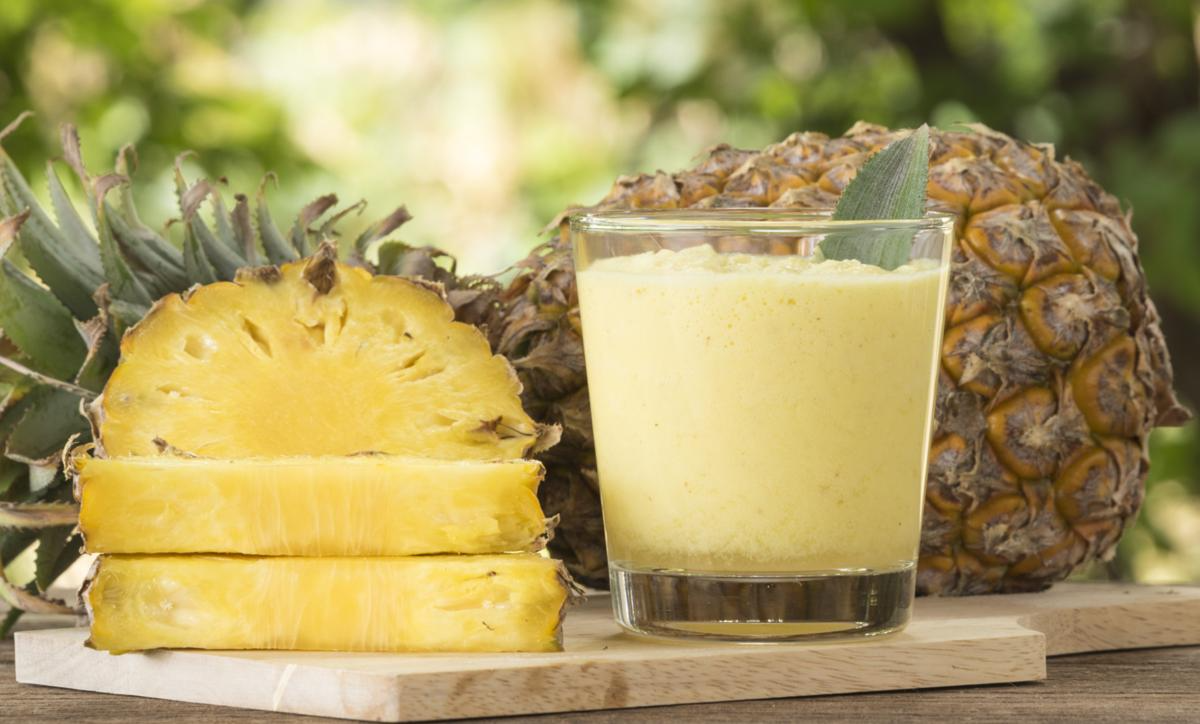 |
The fruit is packed with the enzyme bromelain, which breaks down protein chains, making it an ideal marinade for meats when you don't have a lot of time. But for the same reason, pineapple does not work for jams or jellies, since the enzyme breaks down gelatin as well. The bromelain is so strong that pineapple processors have to wear protective gloves, otherwise, over time the enzyme eats away at the skin on their face and hands, leaving dry skin and small sores.
15. Cucamelons (or "mouse melons") look like grape-sized watermelons but have a citrus flavor
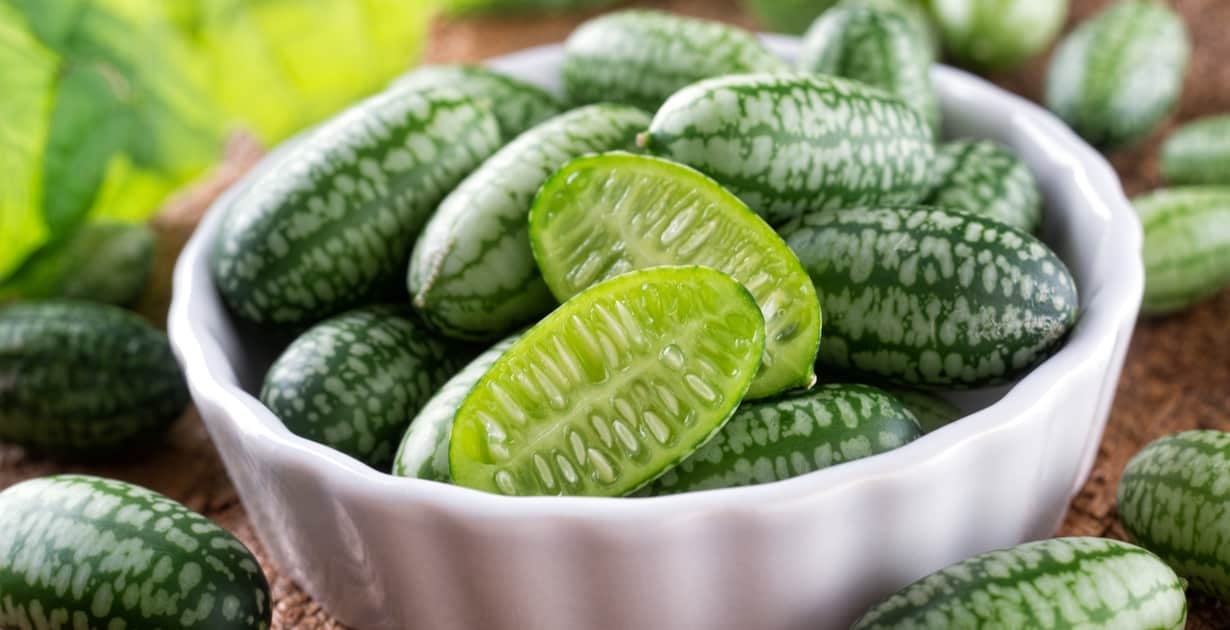 |
| Photo: draxe.com |
Plenty of people enjoy eating watermelon, but have you ever tried a cucamelon? While cucamelons or "mouse melons" sound like they could be related to watermelons—and certainly look like tiny grape-sized versions of the larger fruit—they resemble cucumbers inside and have a citrusy taste. Originally from Mexico and Central America, cucamelons can be eaten as they are, added to a salad, made into salsa, or even pickled.
16. There's no such thing as "pear cider"
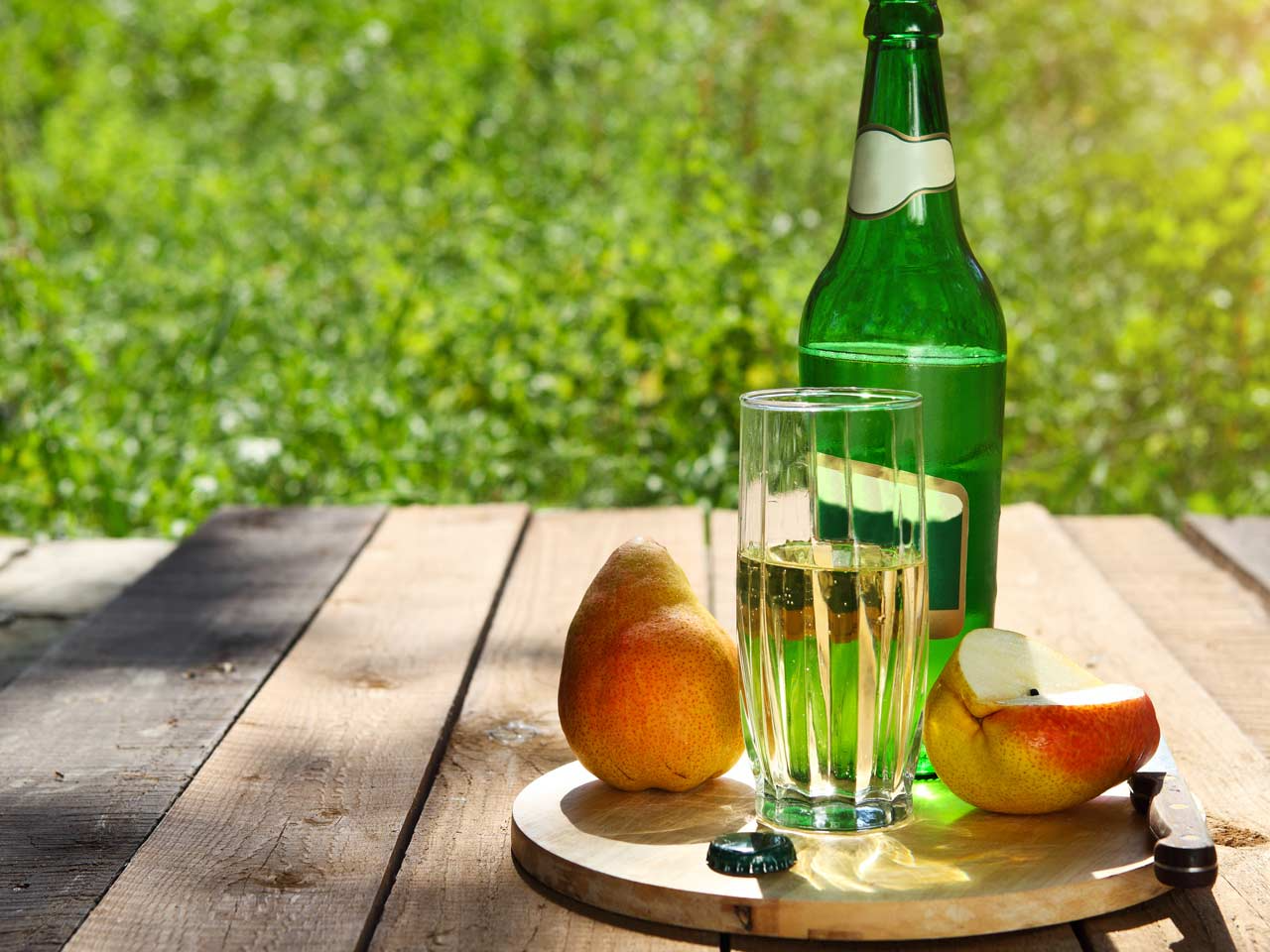 |
"Wait," you're probably thinking, "I had pear cider last week." Actually, "cider" is an alcoholic beverage made from fermented apples and only apples. Alcoholic beverages can be made from pears, but that drink is known as "perry." The drink was popular in England for centuries but fell out of favor during the second half of the twentieth century. That turned around in the 1990s when the drink was rebranded as pear cider.
17. You Have a Nail in Your Body
Iron is an important nutrient that the human body needs. It helps your red blood cells carry oxygen, which is necessary for producing energy, throughout the body, so an iron deficiency can present with a feeling of exhaustion. Amazingly, a healthy adult has enough iron in their body that, if it were pulled out and melted down, it could form a nail up to three inches long.
18. The wood frog can hold its pee for up to eight months
 |
| Photo: sdherps.org |
Talk about having to go! Wood frogs in Alaska have been known to hold their urine for up to eight months, sticking it out through the region's long winters before relieving themselves once temperatures increase. The urine actually helps keep the animal alive while it hibernates, with special microbes in their gut that recycle the urea (urine's main waste) into nitrogen.
19. Peanuts aren’t technically nuts
They’re legumes. According to Merriam-Webster, a nut is only a nut if it’s “a hard-shelled dry fruit or seed with a separable rind or shell and interior kernel.” That means walnuts, almonds, cashews, and pistachios aren’t nuts either. They’re seeds.
20. Walt Disney World would fit inside Canada 81,975 times
 |
| Photo: marketplace.org |
Walt Disney World is a big place, but Canada is way bigger. In fact, the nation up north is so massive (3.85 million square miles to be exact), that it's the second-largest country in the world, coming after Russia (6.6 million square miles) and before the United States (3.79 million square miles). That's why the beloved theme park could fit inside of Canada 81,975 times.
21. The Healthiest Place in the World Is in Panama
A small valley near Volcán in Panama has garnered the distinction of the world’s healthiest place to live. Called “Shangri-La Valley,” this area is home to beautiful scenery, a low cost of living, and a significantly longer life expectancy than the surrounding areas. All in all, the world’s healthiest areas have some common factors: a warm climate, an active social scene, healthy food, and a slower pace of life that makes for less daily stress.
22. The hottest spot on the planet is in Libya
 |
| Photo: theactivetimes.com |
Specifically, the hottest spot ever recorded on Earth is El Azizia, in Libya, where a temperature of 136 degrees Fahrenheit was recorded on Sept. 13, 1922. While hotter spots have likely occurred in other parts of the planet at other times, this is the most scorching temperature ever formally recorded by a weather station.
23. The kangaroo mouse never needs to drink water
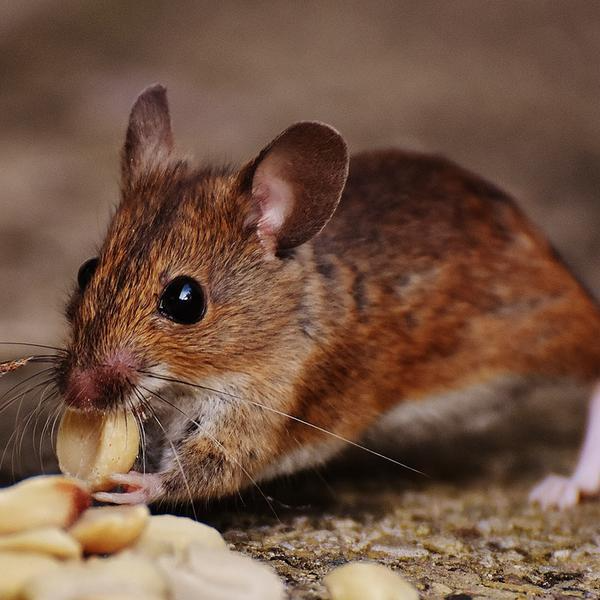 |
Despite being named after an Australian animal, the kangaroo mouse lives in the Nevada desert. And since it resides in such a dry area, it's learned to adapt by getting all of the hydration it needs via the seeds it eats. This means that the kangaroo mouse never drinks water, reported rd.com.
24. Most Disney characters wear gloves to keep animation simple
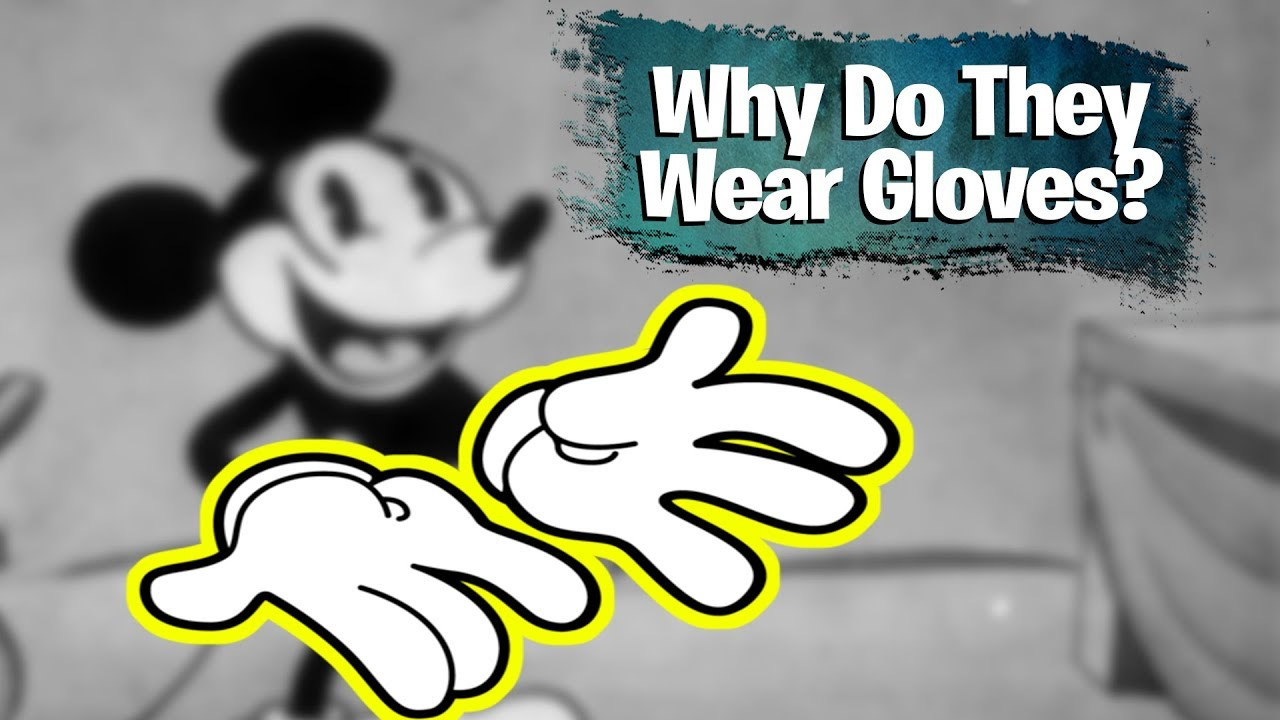 |
Walt Disney might have been the first to put gloves on his characters, as seen in 1929’s The Opry House starring Mickey Mouse. In addition to being easier to animate, there’s another reason Disney opted for gloves: “We didn’t want him to have mouse hands because he was supposed to be more human,” Disney told his biographer in 1957.
25. You lose up to 30 percent of your taste buds during a flight
This might explain why airplane food gets such a bad reputation. The elevation in an airplane can have a detrimental effect on our ability to taste things. According to a 2010 study conducted by Germany's Fraunhofer Institute for Building Physics, the dryness experienced at a high elevation as well as low pressure reduces the sensitivity of a person's taste buds to sweet and salty foods by about 30 percent. Add that dry cabin air affects our ability to smell, and our ability to taste is reduced further.
26. The Accordion Is the Most Popular Instrument in North Korea
 |
| Photo: Youtube |
The most popular instrument in North Korea is the accordion, so much so that all teachers used to be required to pay to get their teaching certifications. Because the accordion is portable in a way that, say, a grand piano isn’t, it was thought of as the “people’s instrument” that could be taken outside and played for laborers in the fields.
27. Japanese golfers have hole-in-one insurance
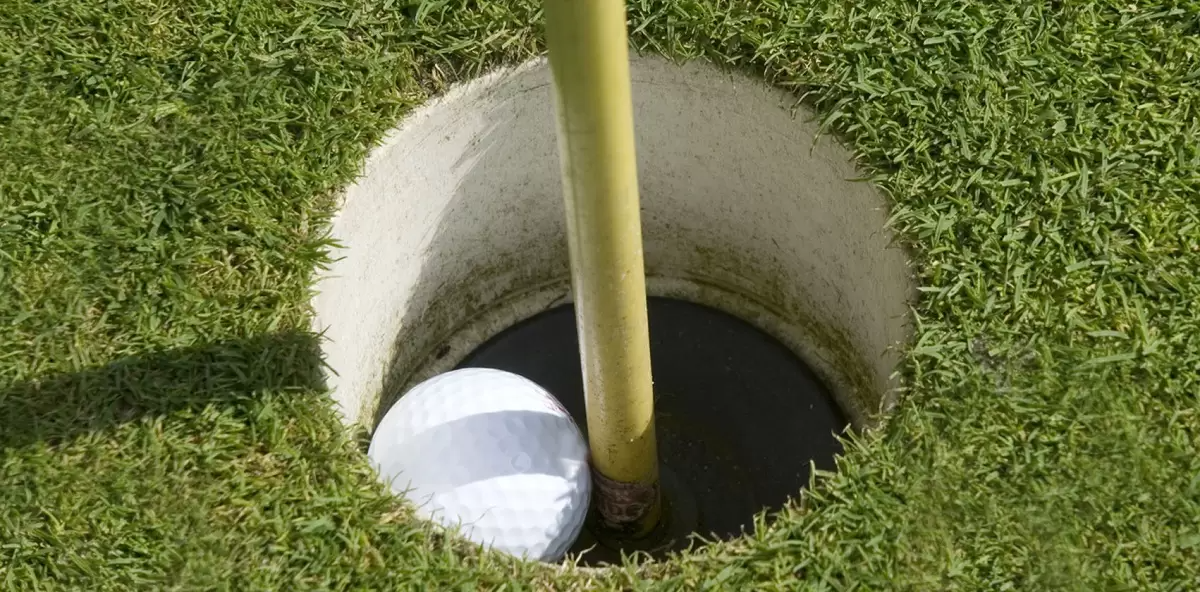 |
If you think that you take sports seriously, consider that an estimated four million golfers in Japan make sure that they have hole-in-one insurance before they take a swing, and have been doing so since the first such policy was offered in 1982. Amateur players pay a premium of $65 a year for $3,500 in coverage. The extra cash comes in handy if a golfer nails the impressive feat and is then expected to celebrate by paying for food, drinks, and gifts, which can cost quite a bit.
28. Your nostrils work one at a time
When we breathe in and out of our nose during the day, one nostril does most of the work at a time, with the duties switching every several hours. This "nasal cycle" is dictated by the same autonomic nervous system that regulates heart rate, digestion, and other unconscious bodily functions and is the reason why—when our nose gets stuffed up—it does so one nostril at a time.
29. Greenland sharks don't reach sexual maturity until they're 150
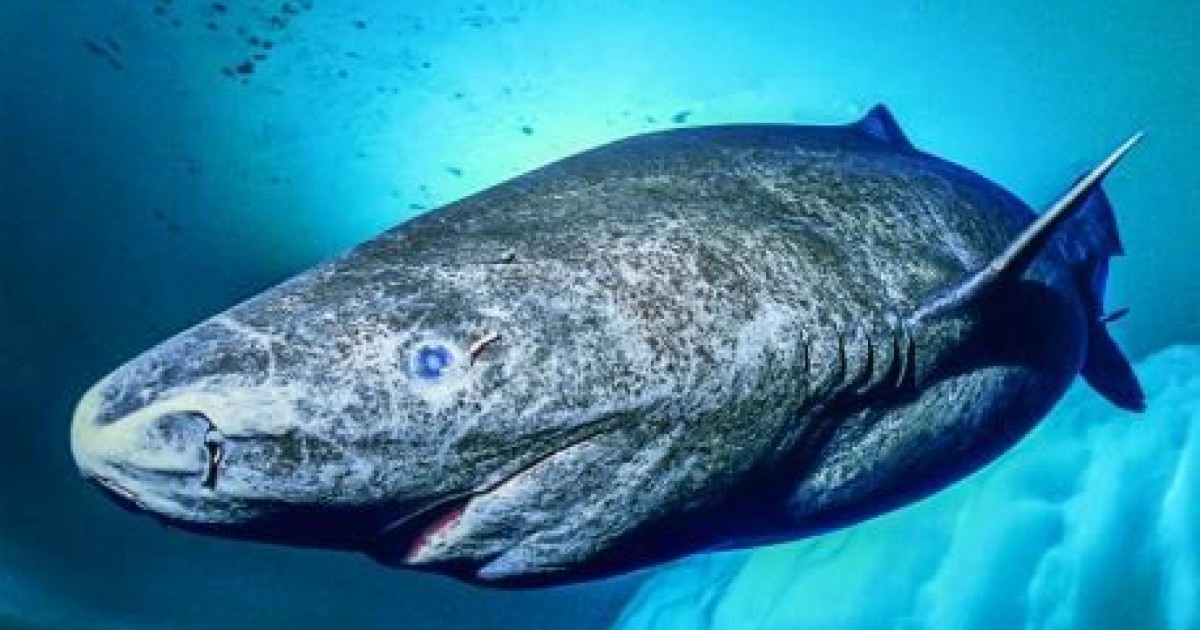 |
| Photo: sciencenordic.com |
Greenland sharks, which are also known as gurry sharks or grey sharks, tend to live long lives. As the longest-living vertebrate on the planet, they can swim around the ocean for up to 400 years and don't reach sexual maturity until they're 150.
30. The longest bicycle in the world is over 135 feet long
If you've ever ridden a tandem bike, you know that it can be tricky to get one moving. So just imagine how hard it must have been to ride a bike that stretched for 135 feet and 10.7 inches, making it the longest bicycle in the world. Crafted by Santos and the University of South Australia in 2015, a group of cyclists did manage to ride the bike—which was much wider than normal in order to compensate for the length—over a distance of 100 meters.
31. The current American flag was designed by a high school student
 |
| Photo: Pinterest |
According to MSN, it started as a school project for Bob Heft’s junior-year history class, and it only earned a B- in 1958. His design had 50 stars even though Alaska and Hawaii weren’t states yet. Heft figured the two would earn statehood soon and showed the government his design. After President Dwight D. Eisenhower called to say his design was approved, Heft’s teacher changed his grade to an A.
32. Only two mammals like spicy food: humans and the tree shrew
While humans have long had the rare distinction of being the only mammal that actually enjoys spicy food, that list has seen a new addition, as a study by Chinese researchers found that tree shrews have a mutation in their ion channel receptor, TRPV1, which makes it less sensitive to the "hot" chemical in chili peppers. As a result, the adorable critters happily gobbled up corn pellets laced with capsaicin (the compounds that give peppers their spice) while other mammals in the study avoided them.
33. There’s a Decorated War Hero Dog
 |
| Photo: warhistoryonline.com |
While in the trenches of World War I, the U.S. First Infantry Division found themselves unable to communicate with other troops because shellfire had damaged the telephone wires.
A young private came up with a unique solution: Rags, a mixed breed terrier whom the soldiers had adopted in Paris, would carry the messages from one division to the next tucked into his collar. He saved many lives, and when Rags passed away—in Maryland, at the very advanced age of 20—he was buried with military honors.
34. A couple once tried to name their child Brfxxccxxmnpccccll-lmmnprxvclmnckssqlbb11116, pronounced "Albin."
Celebrities are known for giving their children unique names—Vogue points out that A-lister kid names include Gravity, Pilot Inspektor, Apple, and, of course, North, Saint, and Chicago. But you don't have to be famous to opt for an unexpected moniker.
According to the BBC, a couple once tried to name their child Brfxxccxxmnpcccclllmmnprxvclmnckssqlbb11116, which is apparently pronounced "Albin." They had reportedly chosen the title to protest Sweden's strict name-related laws, which is why it may not be surprising that their selection was rejected.
35. A chef's toque contains 100 folds
 |
| Photo: free3d.com |
Most diners are too busy looking at their food to look all that closely at what the preparer is wearing, but the toque—the traditional hat worn by chefs—actually contains exactly 100 folds. This is not just a nice, round number: it is said that these folds represent the number of ways to cook an egg, though an investigation by Bon Appetit failed to track down where that saying originated.
36. Humans are the only animals that blush
 |
According to BestLife, we are also believed to be the only animal that feels embarrassment—a complicated emotion requiring understanding others' opinions and other factors. Blushing is caused by the dilation of blood vessels in the facial skin at times of embarrassment.
Darwin considered it “the most peculiar and most human of all expressions”, and it appears to be unique to ourselves. That’s at least partly because we are rare in having our facial skin exposed to the scrutiny of others (though bald uakari monkeys deploy their bright red faces as signals of physiological health).
Moreover, embarrassment is a highly complex emotion that requires knowing what others are thinking about you, which may well be beyond the ken of any other species.
It remains a mystery why evolution should favour a signal that is effectively an admission of guilt, though there’s evidence that, after making a social faux pas, people are regarded more sympathetically if they blush.
37. Rabbits can't puke
According to The Guardian, unlike cats or other animals that can cough up hairballs when they digest too much fur and other indigestible materials, rabbits are incapable of spewing. Their digestive system only goes one way, so the furry critters swallow plenty of roughage, which keeps things moving in the right direction.
38. The longest tiramisu ever measured was 897 feet and 3 inches
 |
| Photo: guinnessworldrecords.com |
If you love tiramisu, then you probably think you could never get too much of the tasty treat. However, you might reconsider that opinion when you find out that the longest tiramisu ever created was 897 feet and 3 inches long. Produced by Italian cheese brand Galbani, students from the Milan Cooking School assembled the giant dessert, which was then divided up and served to those at the record-breaking event, while an additional 15,000 pieces went to a local children's hospital.
39. A Pharaoh Used a Slave to Keep Bugs Away
The pharaohs of ancient Egypt were thought by their people to be literally divine. The word pharaoh itself means “great house,” as in the house of God. King Pepi II, who supposedly ruled for 90 years, thought so highly of himself that when he was bothered by insects, he would command that one of his slaves be covered in honey to lure the flies away from himself.
40. There were active volcanoes on the moon when dinosaurs were alive
Most of the volcanoes probably stopped one billion years ago, but new NASA findings suggest there might still have been active lava flow 100 million years ago when dinosaurs were still roaming.
41. "M's" in M&Ms stand for "Mars" and "Murrie."
 |
| Photo: history.com |
That would be Forrest Mars and Bruce Murrie, the two businessmen who created the candy-coated chocolates. The two actually had a very contentious relationship, as Mars leveraged Murrie out of his 20 percent share in the company in 1949—years before M&Ms would become the best-selling candy in the U.S., paying him just $1 million for a share of the business that would quickly be worth billions.
42. A parking spot in Hong Kong sold for almost $1 million
If you think parking is expensive in your area, you'll be shocked by how much a spot can cost in Hong Kong. A 135-square-foot parking spot in front of the city's fifth tallest building, The Center, was purchased for $969,000. This was the fourth lucrative transaction for businessman Johnny Cheung, who made six figures off of his first three parking spaces. Midland Commercial district sales director James Mak said, "There aren't many car park lots … for sale, so prices have always been kept high." It might be worth sticking to public transportation.
43. Clams have feet
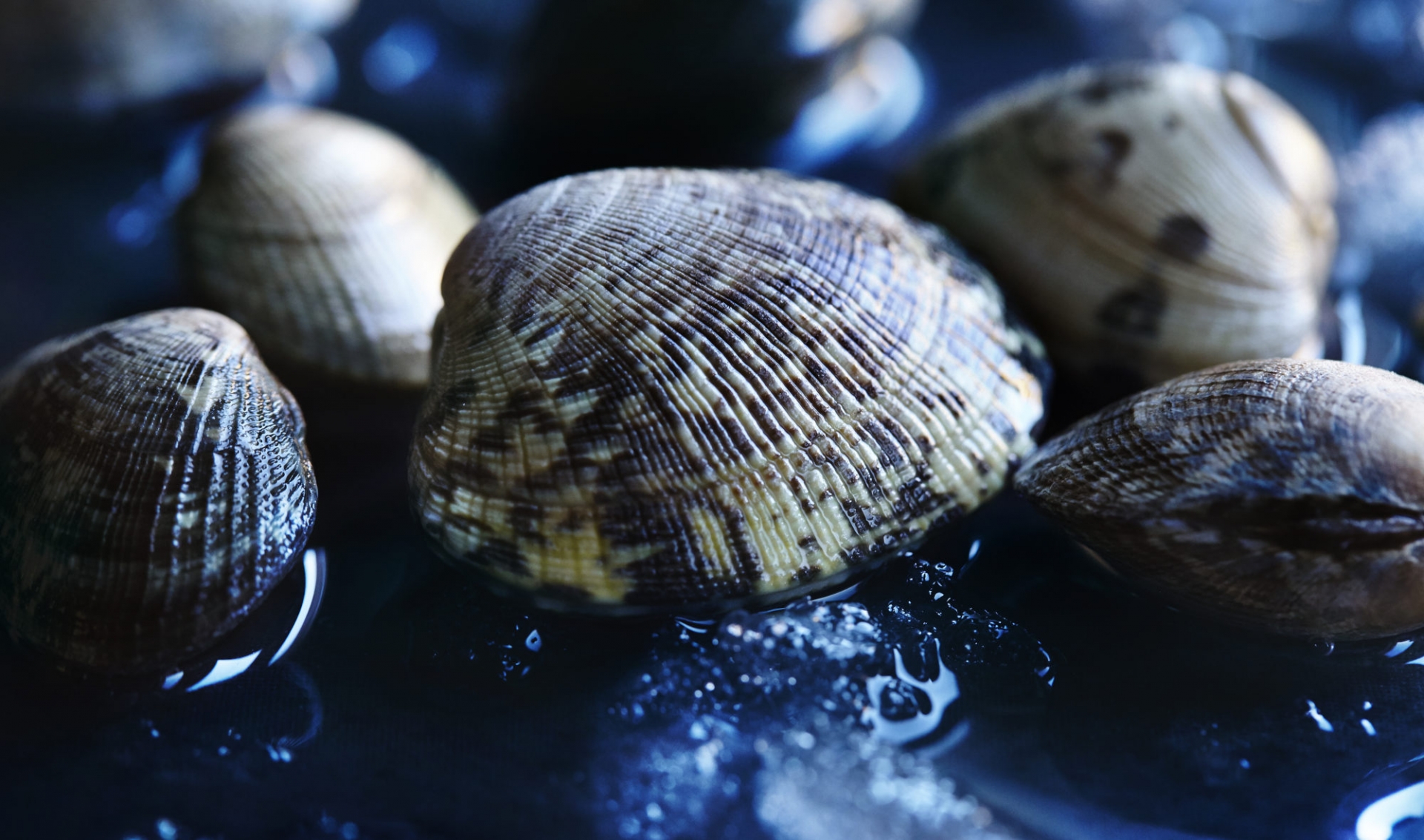 |
| Photo: precisionnutrition.com |
While it might look like clams have a big tongue that sometimes protrudes from their shell to poke around the ocean floor, what you're actually seeing is afoot. The appendage, relatively long in comparison to the overall size of the creature, is used to dig in the sand, according to MSN.
44. The human body literally glows.
It might be hard to see with your naked eye, but everyone you pass by every day is literally glowing. The human body emits a small quantity of visible light ("visible" in the technical sense—the illumination is about 1,000 times less intense than levels of light that we would actually be able to see). Researchers in Japan used a special camera to track this glow and found that it fluctuates throughout the day, with the body emitting its lowest levels of light around 10 a.m. and highest at around 4 p.m., a rhythm the scientists attribute to the changes in one's metabolism.
45. The # symbol isn’t officially called hashtag or pound
 |
Its technical name is octothorpe. The “octo-” means “eight” to refer to its points, though reports disagree on where “-thorpe” came from. Some claim it was named after Olympian Jim Thorpe, while others argue it was just a nonsense suffix.
| What is the # symbol called? 1: The pound sign. This name came to be because the symbol comes from the abbreviation for weight, lb, or libra pondo, literally “pound by weight,” in Latin. When writing “lb,” scribes often crossed the letters with a line across the top, like a t. 2: The number sign. This phrase arose in Britain because pound sign could easily be confused with the British currency. And of course, the # symbol is sometimes spoken as the word “number,” as in “#2 pencil.” 3: The hashtag. The word hash predates these other names (but wasn’t very popular until recently). A hash has referred to stripes on military jackets since as early as 1910. But, in the 1980s, people started using hash to refer to the # symbol. Since the ascent of social media and its new prominence in everyday life, hashtag has become the favored name. 4: The octothorpe. It’s the official name for the # symbol, but what does it mean? It’s actually a made-up word, invented in the same laboratories where the telephone came from. The scientists at Bell Laboratories modified the telephone keypad in the early 1960s and added the # symbol to send instructions to the telephone operating system. Since the # symbol didn’t have a name, the technicians thought one up. They knew it should be called octo- something because it had eight ends around the edge. What happened next is not entirely clear. According to one report, Bell Lab employee Don MacPherson named it after the Olympian Jim Thorpe. Another former employee claims it was a nonsense word, meant as a joke. Another unverifiable report is much more etymologically satisfying: The Old Norse word thorpe meant “farm or field,” so octothorpe literally means “eight fields.” |
46. Cotton candy was invented by a dentist
 |
| Photo: sangbn.vietnhat.tv |
It is not known whether William Morrison had an ulterior motive for inventing the soft confection, but the dentist no doubt helped ensure others in his profession continued drawing in plenty of customers. In 1897, he partnered with candy-maker John C. Wharton to develop the cotton candy machine (which at the time was known as "Fairy Floss"), and it's been bringing kids cavities ever since.
47. Marie Curie is the only person to earn a Nobel prize in two different sciences
The pioneering researcher won the Nobel Prize in Physics in 1903 (shared with her husband) for her study of spontaneous radiation and then won the Nobel Prize in Chemistry in 1911 for her work in radioactivity. That makes her one of just six recipients to receive multiple Nobel prizes, and the only person to receive it in two different sciences. (Chemical engineer Linus Paulding earned a Nobel Chemistry Prize and Nobel Peace Prize, but all other multiple winners received theirs in the same category).
48. Incredible Hulk was originally supposed to be gray
 |
| Photo: thinkingfaith.org |
Marvel's Incredible Hulk is just as well known for his green body as he is for his testy temperament. However, it turns out that he was supposed to be a different, less monstrous color. "Originally, comic book writer Stan Lee and comic book artist Jack Kirby intended the Hulk to be gray," according to Gizmodo, who explain that the color was "very much a riff on Mr. Hyde." But things didn't go as planned when "the printing press kept having trouble with the Hulk's color and he kept coming out green." Because of this, the character only popped up in the first few issues as a furious gray figure.
49. Fingernails don't grow after you die.
Despite what you may have seen on other lists of random trivia, your fingernails and hair do not, in fact, continue to grow after you die. To grow, these must have a steady supply of glucose, which is cut off after the heart stops beating, preventing any further growth. In fact, the skin around the hair follicles and nails dehydrates after death and partly retracts, which can make them appear longer.
50. Dolphins have Been Trained to be Used in Wars
 |
| Photo: allthatsinteresting.com |
Dolphins are known widely as adorable, intelligent animals. What is not as widely known is that these crafty creatures were used largely by the U.S. and Soviet Union during the Vietnam War and the Cold War. Both countries studied the creatures for their sonar capabilities but also trained them to detect mines, bring equipment to divers, find lost equipment, and guard submarines amongst other nifty tricks. Not only do they Sea World, but they can also Destroy the World.
51. The French have their own name for a “French kiss”
 |
This interesting fact doesn’t date that far back. The word hasn’t been around for long. In 2014, galocher—meaning to kiss with tongues—was added to the Petit Robert French dictionary.
References to open-mouthed kissing and kissing with tongues reportedly date back thousands of years in different parts of the world. The association with the French is a more modern phenomenon.
The most popular explanation is that American and British servicemen in France during World War I were struck by the more passionate way French women kissed. When they returned home, they introduced “French kissing” to their compatriots.
Others believe the term simply came to be due to the French people’s general reputation for adventurous and lustful sex practices. Paris is the “City of Love” after all.
52. Mercedes invented the car controlled by a joystick
According to Reader's Digest, the joystick in the 1966 Mercedes F200 showcase car controlled speed and direction, replacing both the steering wheel and pedals. The car could also sense which side the driver was sitting in, so someone could control it from the passenger seat.
53. "Mountain Dew" used to be slang for moonshine
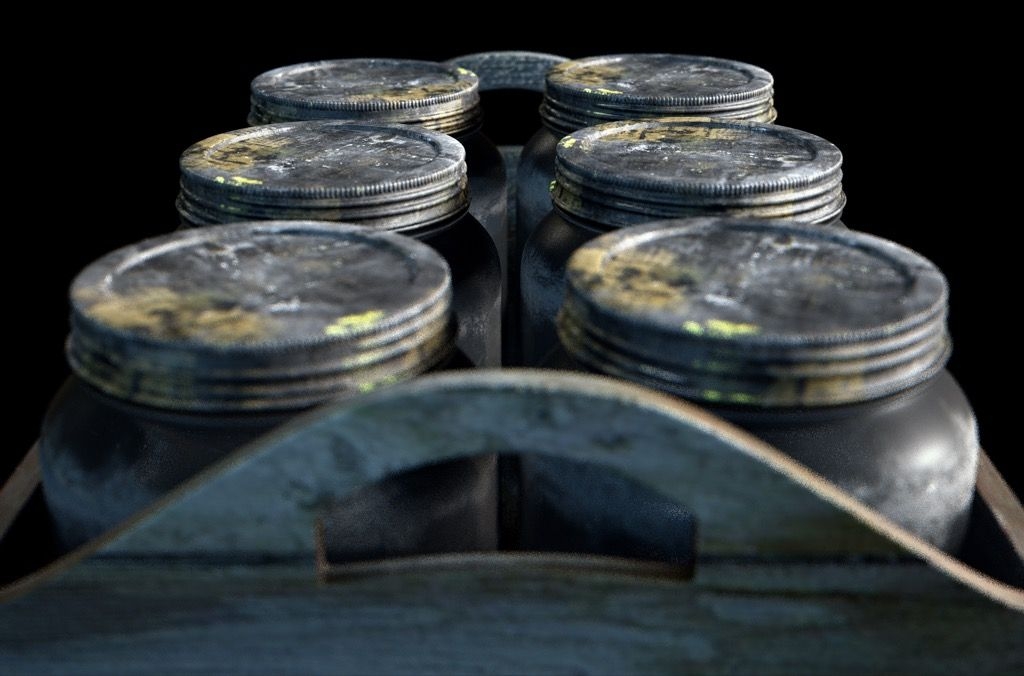 |
| Photo: yahoo.com |
Mountain Dew may be a popular soft drink, but the name used to be slang for moonshine. To back up this claim, Smithsonian points to The Stanley Brothers' tune "Mountain Dew," which is "an Appalachian folk song that most certainly isn't talking about the soda." Instead, the lyrics refer to "good ol' mountain dew" or illegal mountain-brewed booze.
54. Japan has a phone to call the dead
Public phone booths may be a rare sight these days, but there's one located in a Japanese hilltop garden that's especially unusual. The "wind phone" was created by a man named Itaru Sasaki, who thought that it would be a healing (if whimsical) way to talk to his cousin who had passed away—even if the conversation was one-sided. Others now also use the phone in order to feel closer to their late loved ones.
55. The English word with the most definitions is "set"
According to Guinness World Records, "set" has the largest number of meanings of any word in the English language, with 430 different senses listed in the 1989 edition of Second Edition of the Oxford English Dictionary. The word "sets" the record with an entry running 60,000 words, or 326,000 characters, and no other English word has come close since.
56. The Driest Place on Earth Is A Lot Like Mars
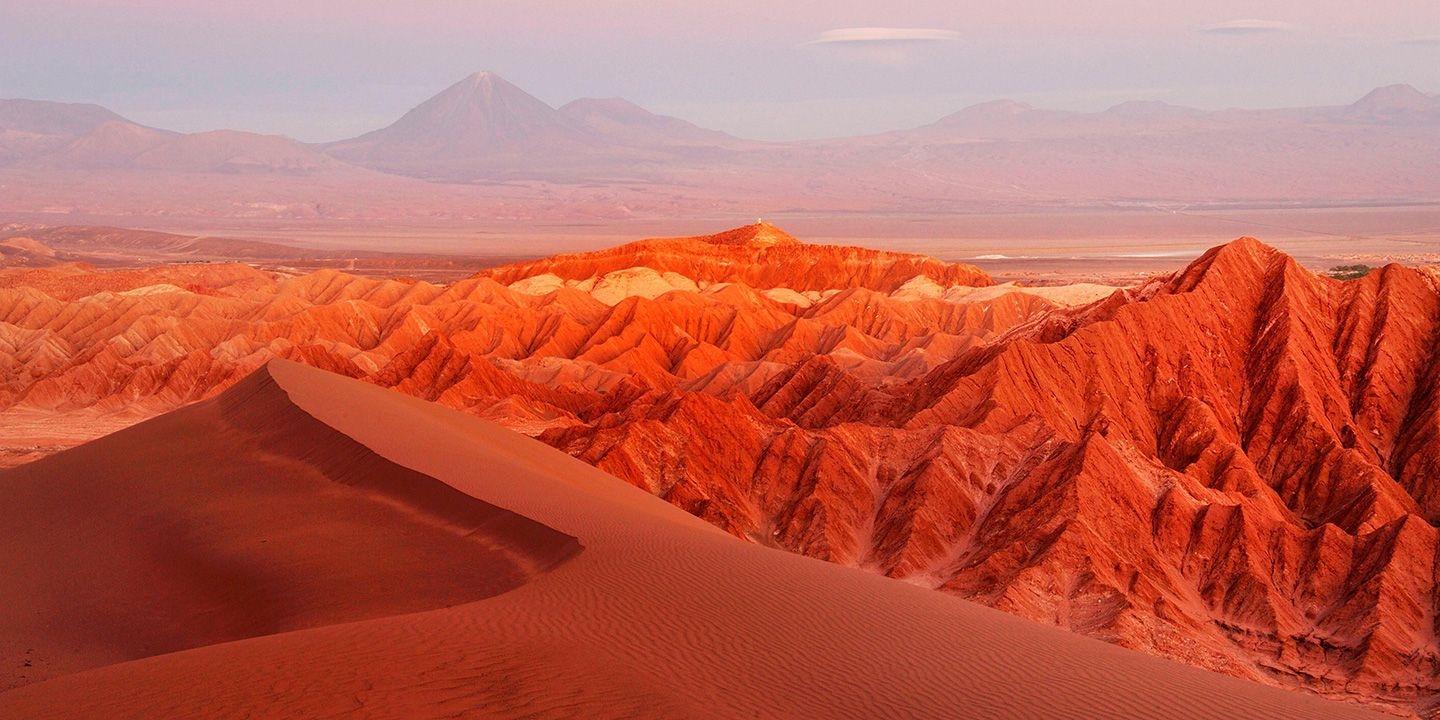 |
| Photo: explora.com |
According to The Guardian, the Atacama Desert in Chile, located on the western edge of South America, may also be the oldest desert on the planet. It’s also the driest. Amazingly, there are some weather stations there that have never reported rain.
At certain altitudes, the soil is so dry and devoid of any kind of life—even microorganisms—that it’s comparable to the soil on Mars. In fact, NASA has sent researchers to this desert to test instruments that will be used on Mars missions.
57. Chewing gum boosts concentration.
Next time you are having trouble focusing, you might want to reach for a stick of gum. A 2013 study in the British Journal of Psychology found that those subjects who chewed gum while taking part in a memory challenge were able to stay focused for longer periods of time than those who did not chew gum.
58. Europeans were scared of eating tomatoes when they were introduced
Scholars think Hernán Cortés brought the seeds in 1519 with the intent of the fruits being used ornamentally in gardens. By the 1700s, aristocrats started eating tomatoes, but they were convinced the fruits were poison because people would die after eating them. In reality, the acidity from the tomatoes brought out lead in their pewter plates, so they’d died of lead poisoning.
59.Superman didn't always fly
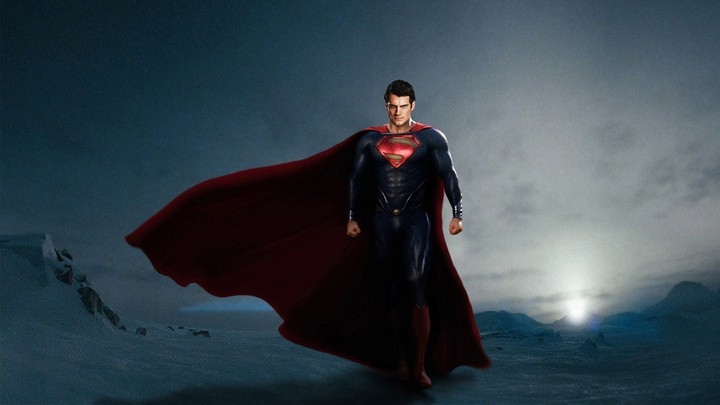 |
| Photo: theatlantic.com |
The original comic book Superman could leap tall buildings in a single bound. But then he had to come right back down to Earth—because he didn't fly. It wasn't until the 1940s when animators for a new animated series decided it would be too difficult to routinely draw him bending his knees, that it was decided that Superman could take off into the air. Readers got to see smooth animation, and a superhero gained a new power.
60. The nonsense phrase "umop apisdn" is "upside down" spelled upside down
Go ahead and flip whatever device you're reading this on upside down, and check out those first two words again. You'll see that "umop apisdn" does indeed spell "upside down" using almost entirely different letters of the alphabet.
61. Redheads Aren’t Going Extinct
 |
| Photo: nerdsandbeyond.com |
Periodically, a rumor starts on the internet that says natural redheads will become extinct by the year 2060. Lucky for gingers everywhere, this is a myth. It’s true that the gene that causes red hair is recessive, meaning that both parents must have it for their child to have red hair. However, even non-redheads can carry the red hair gene, and it can pop up unexpectedly in generations down the line.
62. Every mammal has the same number of neck vertebrae—except for two
Whether it's a giraffe, a mouse, or a human, each mammal has exactly seven vertebrae in its neck. But there are two exceptions to this rule: sloths and manatees. Two-toed sloths have five to seven neck vertebrae, and three-toed sloths have eight or nine; manatees have six, according to 2011 research published in BioMed Central.
63. The word "oxymoron" is an oxymoron itself
According to Merriam-Webster, an oxymoron is "a combination of contradictory or incongruous words." They use "cruel kindness" to illustrate their point. But the dictionary also could have used the word "oxymoron" as an example—since it turns out the word is an oxymoron itself. "Oxymoron" is derived from the Greek words "oxys," meaning "sharp," and "moronos," meaning "dull" or "stupid."
64. Space smells like seared steak
 |
| Photo: indianexpress.com |
When you see footage of astronauts floating peacefully in space, do you ever wonder, What do space smells like? Well, according to some former astronauts, space does have a distinct odor that hangs around post-spacewalk. They've described it as "hot metal" or "searing steak."
65. There is a world record for the largest collection of miniature books
India's Sathar Adhoor has a book collection that is surprisingly huge, especially considering that it's made up of teeny tiny versions of literature. Adhoor is the owner of the world's largest collection of miniature books, which includes 3,137 unique miniature books. (Officially, a "miniature book" can be no larger than three inches in height, width, or thickness.)
66. One Man Saved More than 200 People from Suicide
 |
| Photo: fostertravel.com |
It’s a sad fact the Golden Gate Bridge in San Francisco is a site where many suicides take place. However, one California Highway Patrol officer has done more to combat this problem than any other individual. Officer Kevin Briggs, who battles depression himself, has personally talked more than 200 people down from the proverbial ledge throughout his career. After retiring in 2013, Briggs wrote a book called Guardian of the Golden Gate and now goes on speaking tours to encourage public discussion of suicide and mental illness.
67. The inventor of the microwave appliance only received $2 for his discovery
Percy Spencer was working as a researcher for American Appliance Company (now Raytheon) when he noticed a radar set using electromagnetic waves melted the candy bar in his pocket. He had the idea to make a metal box using microwaves to heat food, but the company was the one to file the patent.
68. The longest wedding veil was the same length as 63.5 football fields
 |
| Photo: guinnessworldrecords.com |
When Maria Paraskeva, a woman from Cyprus, got married in August 2018, her goal wasn't just to say "I do." She was also determined to set a record.
"My dream as a child has always been to break the Guinness World Record title for the longest wedding veil," she explained. She fulfilled her dream by wearing a lace veil that stretched 22,843 feet and 2.11 inches, or as long as 63.5 football fields.
69. The human heart beats more than 2.5 billion times in the average lifetime
Your heart may beat faster when you're excited and could slow down when you're relaxed, but in most cases, it tends to keep a regular pace. In fact, most human hearts beat an average of 60 to 70 times per minute and 100,000 times per day. That's about 35 million times a year, and more than 2.5 billion times during an average lifetime, according to PBS.
70. "E" is the most common letter and appears in 11 percent of all English words
Try writing out a few sentences—anything at all. Now take a minute to look at how frequently each letter in the alphabet appears. Chances are you'll see a lot of the letter "e." That's because the commonly used vowel appears in around 11 percent of all words in the English language, according to Oxford Dictionaries. The next most popular letter was "a," which appears in around 8.5 percent of all words. The least common letter is "q," which appears in just 0.2 percent of words.
71. Oxford University is older than the Aztecs
 |
| Photo: ox.ac.uk |
The Aztec civilization of central Mexico began in 1325 with the founding of the city of Tenochtitlan. That seems like a long time ago—and it was! But you'd have to go back even further to witness the founding of Oxford University, which started as a learning hub as early as 1096. By 1249, the university had established itself as an educational institution with "halls of residence," which still stand today.
72. "Shemomechama" is a Georgian word meaning "I accidentally ate the whole thing."
If you've ever had the intention of enjoying a nibble or two of your favorite treat but ended up devouring every last bit, then you should add "shemomechama" to your vocabulary. The Georgian word, which doesn't have an English equivalent, translates to "I accidentally ate the whole thing."
73. The unicorn is the national animal of Scotland
 |
| Photo: timesknowledge.in |
While Scotland proudly boasts the Loch Ness Monster, one of the world's most famous fabled creatures, the country opted to make another mythical beast its national animal: the unicorn. Although this might seem like an odd choice, Visit Scotland explains that unicorns played an integral role in the country's history. Back in the 12th century, William I used the "proud beast" in the Scottish royal coat of arms.
74. The world's most expensive hot dog costs $169
The Tokyo Dog food truck in Seattle, Washington, charges $169 for its "Juuni Ban," making it the world's most expensive hot dog. The hot dog includes smoked cheese bratwurst, butter teriyaki grilled onions, maitake mushrooms, Wagyu beef, foie gras, shaved black truffles, caviar, and Japanese mayonnaise on a brioche bun.
75. European Ancestors Were Cannibals
In 16th and 17th century Europe, cannibalism was actually a fairly common practice, and it was all for medical purposes. The practice seems to have started because Egyptian mummies were thought to have magical curative properties and so were ground up and put in many remedies.
As the idea evolved, human bone, blood, and fat were all used in medical concoctions. Got a headache? Crush a skull and make it into tea! While medical cannibalism has, thankfully, fallen out of favor, modern medicine still sometimes uses one human body to heal another in the form of blood donations, organ transplants, and skin grafts.
76. Dogs Actually Understand Some English
 |
| Photo: alphapaw.com |
According to MSN, some owners of disobedient dogs may have trouble believing this, but dogs can learn to recognize a vocabulary of about 165 words. Unsurprisingly, dogs respond best to short words, as well as words with hard consonants like T or R, which may explain why they can hear “treat” from three rooms away.
If you want to try to expand your dog’s vocabulary, be consistent—for example, always call a meal “dinner” instead of breakfast, lunch, or supper. And don’t believe the myth: old dogs can learn words just as well as young dogs.
77. A dozen bodies were once found in Benjamin Franklin's basement
The bones were discovered during a 1998 renovation of the house and were identified as being from nearly a dozen people, including six children. "The most plausible explanation is not mass murder, but an anatomy school run by Franklin's young friend and protege, William Hewson," wrote The Guardian.
That's not to say there wasn't any funny business going on. "The resurrection men could deliver bodies stolen from graveyards to the Thames wharf at the bottom of the street, while there was a weekly public execution at the gallows on the other side of the garden wall," the publication reported.
78. There's a desert in Canada
 |
| Photo: thestar.com |
When you think about Canada, you probably imagine acres of forests and lots of snow. But it turns out there's also a desert in the Great White North. According to The Star, "the grasslands and bald hills outside the town of Osoyoos are an extension of the Sonoran Desert that runs as far south as Mexico and creeps north to form Canada's only arid desert." The area in British Columbia is home to 100 rare plants and 300 creatures that can't be found anywhere else in the country, such as painted turtles, scorpions, and pygmy short-horned lizards.
79. Some people have an extra bone in their knee
If you were under the impression that the human body had finished evolving, think again. It turns out that some people have a bone in their knee called a fabella. And while this particular little bone with an unknown purpose was once fading away, over the last century and a half, it's gotten more common. Back in 1875, nearly 18 percent of people examined had a fabella. That number dropped to 11 percent by 1918. However, by 2018, 39 percent of individuals had this mysterious bone.
80. A barista set a world record for making 420 cappuccinos in an hour
 |
| Photo: worldrecordacademy.org |
If you're heading to your local coffee shop and need your drink ASAP, then hopefully you'll end up with a barista like Liza Thomas. The Australian woman set a world record when she made 420 cappuccinos in just one hour. According to Guinness World Records, "Liza's attempt had the added pressure of taking place in public, with fellow colleagues and café goers watching her every move and enjoying the cappuccinos, which were given away as she made them."
81. Stars don't really twinkle
"Twinkle, Twinkle Little Star" may have led us to believe that the massive celestial bodies in the night sky are sparkling, but it turns out that the flashing we see is merely a "space mirage." The light that emanates from stars is steady and constant, but Earth's atmosphere interferes with what we witness, which is why they appear to twinkle.
82. Pringles Aren’t Technically Potato Chips
 |
| Photo: delish.com |
The next time you see a can of Pringles, take a closer look—you won’t see the word “chip” anywhere on the packaging. That’s because Pringles aren’t made of thinly-sliced potatoes, but instead, dehydrated potato flakes pressed into their signature parabolic shape. That’s what makes them less greasy, but when other potato chip manufacturers complained, the FDA ruled that Pringles couldn’t be marketed as chips. The company eventually settled on “potato crisp.”
83. The creature is a vegetarian
Victor Frankenstein’s Creature is actually vegetarian. Frankenstein and Creature are fictional characters created by Mary Shelley in her novel, Frankenstein. In the novel, Creature says, “My food is not that of man; I do not destroy the lamb and the kid to glut my appetite; acorns and berries afford me sufficient nourishment.”
84. Armadillos almost always give birth to identical quadruplets
 |
| Photo: Wikipedia |
Having multiple babies at one time is normal for the nine-banded armadillo. This creature, which can be found throughout the Americas, almost always gives birth to quadruplets, with each newborn pup identical to its siblings.
85. Most Laughter Isn’t Because Things Are Funny
Every culture in the world laughs, but surprisingly, most of our laughter isn’t necessarily a response to humor. Only 20 percent of laughter comes after jokes; the other 80 percent is a reaction to regular statements and questions like, “How have you been?” The ensuing laughter, however brief, helps form social bonds—people who laugh together grow closer.
86. Medical errors are a top cause of death
According to a Johns Hopkins research team, 250,000 deaths in the United States are caused by medical errors each year. This makes a medical error the third-leading cause of death in the country.
87. Sloths have more neck bones than giraffes
 |
| Photo: leakeyfoundation.org |
Despite the physical length, there are more bones in the neck of a sloth than a giraffe. There are seven vertebrae in the neck of giraffes, and in most mammals, but there are ten in a sloth. Still, giraffes are among 23 of the world’s biggest living animals.
88. There's a giant fish with a transparent head
The deepest levels of our oceans are some of the least explored areas of the planet. Because of the extreme pressure, cold, and dark at these depths, only the very strangest of creatures can survive there. These include giant tube worms, vampire squids, goblin sharks, and viperfish with teeth so long that they can't close their mouths. Perhaps the strangest, though, is the barreleye, a large fish with a completely transparent head.
89. Showers really do spark creativity
Showers aren't just good for your hygiene—they're good for your creativity, too. For a 2012 study published in the journal Psychological Science, researchers gave volunteers creativity problems to solve followed by a period of rest. During that period, some were assigned demanding tasks, while others did simpler tasks that allowed their minds to wander (just like a shower does). Those doing the simpler tasks during the resting time were more likely to solve the original creativity problems.
90. Pro Baseball Once Had Women Players
 |
| Photo: britannica.com |
While there are currently no female players in Major League Baseball, there have been plenty of women in professional men’s leagues. The first was Lizzy Arlington, who in 1898 pitched the ninth inning for the Reading Coal Heavers and won her team the game.
A little over 30 years later, an African-American woman, Jackie Mitchell, pitched against the Yankees during an exhibition game, striking out both Babe Ruth and Lou Gehrig. What’s more impressive: Mitchell was 17 years old at the time.
For more fun and interesting facts about our world, please click here!
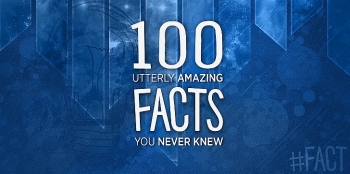 100 Fun and Interesting Facts about Everything Would Blow Your Mind! (Part 3) 100 Fun and Interesting Facts about Everything Would Blow Your Mind! (Part 3) There are endless mysteries that have yet to unveiled. From amazing natural phenomena to unpredictable inventions. Stay tuned with KnowInsiders to know more about our ... |
 100 Fun and Interesting Facts about Everything Would Blow Your Mind! (Part 2) 100 Fun and Interesting Facts about Everything Would Blow Your Mind! (Part 2) There are endless mysteries that have yet to unveiled. From amazing natural phenomena to unpredictable inventions. Stay tuned with KnowInsiders to know more about our ... |
 100 Fun and Interesting Facts about Everything Would Blow Your Mind! (Part 1) 100 Fun and Interesting Facts about Everything Would Blow Your Mind! (Part 1) Our large world contains truly a lot of mysteries and interesting things. From amazing natural phenomena to unpredictable inventions. Stay tuned KnowInsiders to know more ... |


























